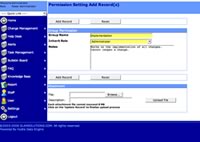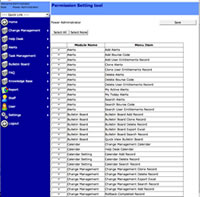
Email newsletter of SLAM Solutions Inc., makers of web based software. Click here to view this page through your web browser if you are having trouble viewing this email. If you received this email in error or do not wish to receive future email from SLAM Solutions,
NEW! - Advanced Permission Settings
Powerful feature allows any number of permission levels for Change Management Control and Help Desk Control Software Systems
December 4, 2006 — Las Vegas, NV —Adding to its already strong line-up of customizable features, SLAM announces the Advanced Permission Settings Tool by which unlimited groups may be configured. Based on the request of an existing customer, both Change Management Control and Help Desk Control now come with the ability to set up as many custom permission- based groups as a company or organization needs. Groups can be added at any time and can contain any number of logins.
Mazhar Pathan, Development Manager for SLAM, explains further: “The software is based on the concept of three types of master user Groups: Admins, Staff and End Users as well as a number of Modules or tools that comprise the capabilities of the software. Under each of these groups, any number of sub-groups are now possible and each subgroup can have its own set of Modules or capabilities.”
“As an example, I may be a programmer that updates server code, but I do not have the decision power to approve new updates, and I have no need to run reports or publish FAQ’s or Bulletin Board entries. The Power Administrator of my company can set up a new Staff subgroup entitled: “Change Management Programmer” that only has permissions to complete Change Management issues that are assigned to staff of that group for implementation. Nowhere on my navigational console will I have the ability to assign and approve changes, run reports, update FAQ’s or Bulletin Board notices – my only job is to program code, go to the Change issue and sign off that it has been completed and implemented. By creating this new group, “Change Management Programmer”, staff assigned to that group will only see the modules that their group has been granted permission to use.”
In addition to the ability to customize the software’s fields, business rules, and navigation, the new Advanced Permission Setting is accessed through the system’s web interface. There is no need for database, server work nor any html or other scripting. The ability to create groups is limited to the Power Administrator, a new level of the Admin group. Limiting this extremely powerful feature insures that controls remain in place for the overall administrator of the system, but gives the administrator the ability to create the groups he/she needs for the optimal performance of the software on the fly.
“Change Management Control and Help Desk Control were developed and integrated based on customer feedback and ITIL best practices. No one else in the industry has a tool, that can be configured as quickly and simply as Advanced Permission Settings – this really puts SLAM software in a class of its own,” remarked Mr. Pathan.
SLAM Change Management Control and Pink Verify
SLAM has begun the process to certify Change Management Control under the Pink Elephant Verify Program. Pink Elephant is a company that specializes in the certification and implementation of ITIL standards - you can read more about them here.
As part of the verification, we have prepared our initial assessment and present the questions and answers to you here: (also available in PDF format, please click here to download)
Abbreviations:
*RFC= Request for Change
*CI= Configuration Items
*RFC= Request For Change
- Does the tool facilitate the recording and storage of RFCs in an easily accessible format?
YES. The tool is a web based, .NET application with a SQL, Access or Oracle backend database. The tool is accessed by # Internet Explorer 5.5+, Netscape 7+, Opera 7+, Mozilla 1.4+, or Mozilla Firefox. Fields are customizable to accommodate that best means of input and storage for RFCs. - Does the tool allow only authorized personnel to submit RFCs?
YES. The tool is governed by permission based logins and passwords. Administrators set up and maintain profiles for all users of the system. Only users with authorization log in and are able to submit RFCs. - Can the tool support the entry of free text as well as the use of codes for RFC classification (category and priority)?
YES. Change Management Control can be customized to utilize the database field types that support the entry of free text as well as codes. These field types include Memo Box (free text), Text Field (free text), Drop Down Menus, (useful for codes or classification), Multi Select Fields (again, useful for codes or classification, Time and Date Fields, Radio Buttons and other database field types. - Does the tool facilitate the monitoring and tracking of the life cycle of a Change request? For example, tracking a Change through the different stages of authorization, coordination, and review.
YES. Every stage is clearly defined in three areas of the RFC:
1. By the workflow graphic at the top of the RFC
2. By the Change Management Workflow Box where authorized personnel are able to go in make approvals and rejections for each stage of the change
3. By the Approved/Rejected audit trail/history grid on the RFC where the Submitter, Date & Time, Stage and Approved Rejected Comments are all tracked. - Does the tool facilitate the ability to control, read, write, and modify access for Change Management staff, Change builders, testers, etc. to update Change records throughout the Change lifecycle?
YES. The tool is governed by permission based logins and passwords. Administrators set up and maintain profiles for all users of the system. Only staff with authorization are able to log in to control, read, write and modify access for Change Management staff. Various levels of permissions can be configured into the system (i.e... submitter versus tester). Moreover, when a change is reviewed by the Change Manager, they assign which staff will be involved in each stage of the RFC. - Does the tool facilitate the routing of RFCs to the appropriate authorization bodies as defined within the ITIL Change Management Process? For example, Category 1 – Change Manager, Category 2 – Change Advisory Board, Category 3 – IT Executive.
YES. Change Management Control utilizes business rules to set up both automatic assignment (routing) and notification (email) to the appropriate parties based on the categories, codes or priorities associated with a RFC. (in other words, based on values chosen from category or priority fields). These business rules are able to be set up and modified by the System Administrator through the Settings Tool (web interface). - Does the tool facilitate the ability to reject Changes? For example: Status of reject, ability to record reason for reject, notification to the Service Desk and End Users.
YES. Rejection is an option at every stage in a workflow. At every change of stage, be it approval, rejection, or hold (pending), email notifications can be sent out to all interested parties (through Email Notification Settings) - Does the tool facilitate the recording of impact assessment information within the Change record in order to support the Change authorization process? For example, the embedding of attachments such as technical reviews and reports.
YES. There is the option of including fields for impact assessment or attaching multiple files of any kind to the RFC. - Does the tool facilitate the production of Change schedules? For example, build, testing, and implementation schedules.
YES. Each RFC can have date and times associated at various stages. These dates and times are logged and displayed in the Calendar feature of the tool. - Does the tool facilitate the recording of back-out procedures within the Change record?
YES. The tool allows for backout procedure steps to be recorded. - Does the tool facilitate notification and escalation throughout the Change lifecycle should Service Levels be breached?
YES. Included in the tool is a Settings Function, that allows administrators of the system to set up email notification rules and escalation rules according to the organizations' Service Level Agreements. - Does the tool facilitate the scheduling of Change reviews for implemented Changes after definable time periods?
YES. Users have the option of including any additional stage in the workflow or a change. Adding the stage of Change Review along with accompanying business rules (Alarms and Email Notifications) allow for the scheduling of change reviews after definable time periods. - Does the tool facilitate customization of reporting functions? For example, ability to build custom report types based upon multiple field, multiple record selection.
YES. The tool allows for reports to be generated based on searches over multiple fields. These reports can be displayed as charts, tables and/or audit reports. The results can also be exported to Microsoft Excel. The system also integrates with third party reporting tools such as Crystal Reports.
About SLAM Solutions
Headquartered in Las Vegas, NV, SLAM is a group of software developers, engineers and marketers dedicated to providing solid solutions for clients of all sizes and budgets.
SLAM Solutions is targeted on providing the best web based solutions for clients big and small. We help customers across a broad range of industries increase efficiency and productivity through the design and implementation of advanced web based software solutions. Check out all of our products:
SLAM Solutions Phone:
Tel: 702-966-0779
Toll Free: 877-413-4094
Fax: 702-967-0798

